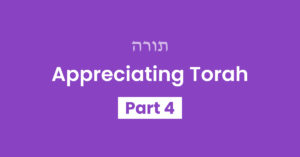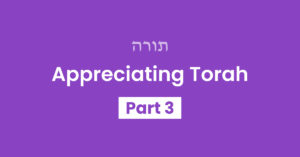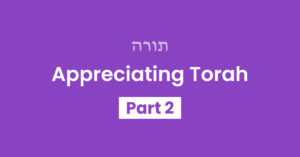We have just entered the Hebrew month of Sivan, the month in which the Jewish people received the Torah. Later this week, many people will stay up learning Torah on Shavuos night, and we will eat festive meals to celebrate our joy in having the Torah.
Why is the Torah so central to our lives, and why do we give it so much honor?
To understand why the Torah is so special, we can consider the words of Chazal who say: The Torah existed even before Hashem created this world. To be exact, Hashem created the Torah 974 generations before creating this world.1 Why would Hashem create the Torah BEFORE creating this world? Wouldn’t it make more sense if Hashem FIRST created human beings, and THEN created the Torah, to teach us how to live our lives?
The Torah existed even before Hashem created this world.
As Rav Yerucham Levovitz explains2, this view is actually looking at the world though a backwards perspective. It’s not that Hashem first decided to create us with parents, and only then gave us the mitzvah of Kibbud Av V’Aim, so that we would treat our parents properly. Or that Hashem first created money, and only then gave us the mitzvah of Tzeddakah so that we would use our money properly.
Rather, the opposite is true: Hashem first created the Torah, in which the mitzvah of Kibbud Av V’Aim is written. Only then did He create us with parents, so that we would be able to fulfill this mitzvah. Hashem first created the Torah, which includes the mitzvah of Tzeddakah, only then did He create money, so that we would be able to fulfill the mitzvah of Tzeddakah. Everything in this world was created ONLY for the purpose of enabling us to keep the mitzvos of the Torah. The Torah was created first, and everything else was created afterwards, following in the Torah’s lead.
Everything in this world was created ONLY for the purpose of enabling us to keep the mitzvos of the Torah.
This is the meaning of the famous line from the Zohar3: “Histakeil Ba’Oraisah U’bara Olma – Hashem looked into the Torah, and created this world.” Hashem looked into the Torah – saw the mitzvos written in the Torah – and then based on these mitzvos, He created all parts of this world that would be necessary to enable us to keep these mitzvos.
This fundamental concept is also hinted to in the first passuk of the Torah, “Bereishis Bara Elokim.” Rashi4 explains this passuk to mean “Bishvil Reishis, Bara Elokim – Hashem created this entire world for the purpose of Torah (which is sometimes called ‘Reishis’).” Everything in this world – trees, flowers, fish, elephants, the moon, and my arm – were created only in order to enable us to fulfill the mitzvos of the Torah.
Living on a Higher Plane
With this introduction, we can now understand why learning Torah is so central to Judaism, why every Sefer Torah is treated with so much honor, and why those who dedicate their lives to the study of Torah are held in such high esteem.
When we learn Torah, we are not just reading a storybook or textbook. Rather, we are connecting to something much greater – something that exists on an entirely different plane. The Torah was created even before this physical world was created, and therefore it exists on a higher plane, somewhere beyond the limitations of this physical and time-bound world. When a Jew learns Torah, he is reaching beyond the physical boundaries and limitations of this world, and connecting to something infinite and timeless.
We are connecting to something much greater – something that exists on an entirely different plane.
For this reason, one of the 13 Ani Maamin’s (Principles of Faith) is: “I believe with perfect faith that the Torah will never be changed.” Why can’t the Torah ever be changed?
Rav Yerucham Levovitz5 explains: The Torah is the blueprint for the entire Creation. When someone builds a house, first they plan and draw the blueprint, and then they build all elements of that house, according to the details that were outlined in the blueprint. If the blueprint says to include 3 bedrooms, 2 bathrooms, and 1 kitchen… then the house will have 3 bedrooms, 2 bathrooms, and 1 kitchen. The blueprint doesn’t change; rather, the house changes and evolves over time to reflect the plan that was outlined in the blueprint.
The Torah is the blueprint for the entire Creation.
The same is true of this physical world. The Torah is Hashem’s blueprint for this world, and it will never be changed. Instead, the physical world itself will continuously evolve and change to come closer to ultimate goal outlined in the blueprint of the Torah – that all of mankind should come to recognize Hashem as our Creator. The physical world may change over time, but the Torah will never change.
Thinking in this way may be different from what we are used to. But the more we appreciate this truth – that everything in this world was created only for the sake of Torah and mitzvos – the more we will appreciate the Torah’s infinite value, and treat it (and those who study it!) with the respect and honor it deserves.
This week, in order to deepen our sense of Kavod HaTorah, let’s practice looking at some things in this world and remembering that everything was created only for the purpose of enabling us to keep Torah and mitzvos.
| Sources: [1] Shabbos 88b; [2] Daas Torah: Shemos pg. 221; [3] Zohar: Introduction 72; [4] Rashi on Bereishis 1:1; [5] Daas Torah, ibid. |
Your Challenge
Once a day, notice an object in this world and say how it was created for the purpose of Torah.
FOR EXAMPLE:
- Hashem created this table so that we can use it for eating our Shabbos meal.
- Hashem created my arm so that I can wear tefillin.
- Hashem created this chair so that I can sit on it while I learn Torah.
- Hashem created this dress so that I can wear it l’kavod Shabbos.
Torah Questions
- According to Tehillim 19:11, the words of Torah are sweeter than _____?
- According to Mishlei 3:15, the Torah is more precious than _____?
- According to Mishlei 3:18, the Torah is compared to _____?
- What promise regarding the Torah was made to Bnai Yisroel in Devarim 31:21? (See Rashi)
- According to Rashi (Devarim 11:16), what will happen if someone separates himself from the Torah?
- According to the Gemara (Shabbos 88b), Hashem created the Torah ___?___ generations before the world was created.
Questions to Ponder
- The Zohar says that Hashem was “playing” with the Torah for 2,000 years before the world was created. What do you think this means? What lesson are we supposed to learn from this statement?
- Chazal teach us that all 613 mitzvos are contained in the 10 Commandments, and all 10 Commandments are contained in the word “Anochi.” How could this be? What does this mean?
- Rav Yerucham Levovitz writes that learning Torah is the only way to know Hashem, and “see Hashem face to face.” What do you think this means? And why is learning Torah the only way to know Hashem? Can’t we come to understand Hashem by looking at Hashem’s creations, like Avraham Avinu did?





